Last Updated on February 21, 2025 by Admin
LinkedIn is the most used social network for people looking for jobs. The platform allows you to find jobs based on your profile, location, and connections. Kindly read this LinkedIn job search guide and optimize your profile to stand out.
It also features an algorithm that automatically gives suggestions based on what you like to do or your industry. LinkedIn allows you to thoroughly research a company thanks to its information pages, which can be accessed from the company page or a job offer.
Table of Contents
Why Use LinkedIn Jobs Search?

It’s no secret that LinkedIn is the top professional social networking site, reaching 200 countries and territories worldwide.
LinkedIn has over 1 billion users, over 6 People are hired every minute, and 65 million people use LinkedIn to search for jobs on LinkedIn weekly. Find the practical and proven strategy to optimize your LinkedIn profile and job search in 2025.
LinkedIn’s global headquarters are in Sunnyvale, California, with Europe, Middle East, and Africa headquarters in Dublin and Asia Pacific headquarters in Singapore.
Current LinkedIn Stats 2025
- LinkedIn currently has over 1 billion members in 200 countries and regions worldwide
- 67 million-plus companies listed on LinkedIn
- Over 125 Job applications are submitted every second
- 28 Million+ + members are taking advantage of the #OpenToWork photo frame
- 65 Million People use LinkedIn to search for jobs each week
- 6 People are hired every minute on LinkedIn
- 134,000 Schools listed on Linkedin
- 41,000 Skills listed
- LinkedIn is responsible for 80% of B2B leads from social media.
Click this link to check the other LinkedIn statistics for the year 2025.
LinkedIn Profile Optimization Tips for Job Seekers
It can be easy to ignore your LinkedIn profile when you’re not looking for a job. But, when you are fresher and more serious about finding your first dream job or changing your current position, LinkedIn is the best place.
We have discussed some of the primary and essential points to strengthen your LinkedIn profile and use all the Linkedin jobs search features to attract the attention of the recruiters.
Below are some tactical tips on leveraging LinkedIn to its fullest to expand your professional network to land your next job and learn more about how to find jobs on LinkedIn.
Read on for expert-backed ways to make your LinkedIn profile soberly shine and start getting noticed by recruiters.
Related Post:
- Did you miss the Campus Placements? How to search for your dream job?
- Top Job Websites and Job Portals In India For Freshers
- All about Construction Management
- Top Construction Companies in the World
- Effective Job Search Strategies for Engineers: Ebook
Update(Complete) your Profile
LinkedIn members with a profile picture are 21 times more likely to receive page views and nine times more likely to receive connection requests.
Per LinkedIn’s blog, those who post skills are 13 times more likely to have profile views than those who don’t.
Add a profile picture, skills, achievements, and other essential features, and regularly update your profile.
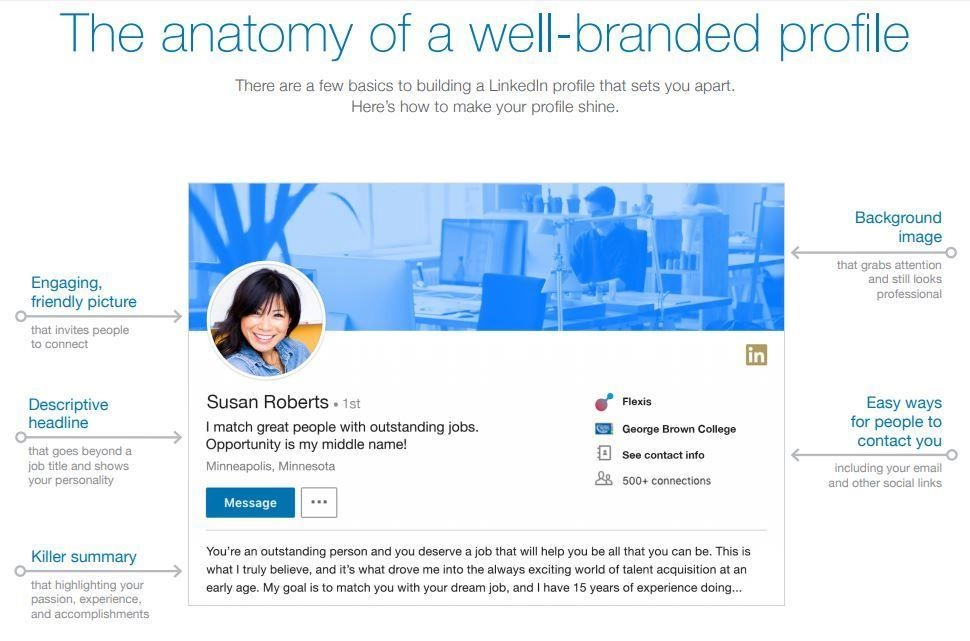
Steps to follow
- Login to your account
- Click on your profile picture
- Click on the Edit (pencil symbol) on the right side of your profile picture.
- Add all the relevant and authentic information about yourself. Fill in all the fields and complete your profile.

Sections you can display on your profile.
- Introduction section – The top section of your profile displays details of your current personal and professional status. This includes:
- Name
- Profile photo
- Background photo
- Headline
- Current position
- Education
- Location
- Industry
- Contact Info
- Summary
- Open to finding a new job
- Experience – Professional positions and experience, including jobs, volunteering, military, board of directors, nonprofit, or pro sports.
- Education – School and educational information.
- Licenses & certifications – Certifications, licenses, or clearances you’ve attained.
- Skills – A relevant list of skills on your profile helps others understand your strengths and improves your likelihood of being found in others’ searches.
- Recommendations – You can request professional recommendations from your peers.
- Courses – Adding your body of coursework can help your education stand out.
- Honors & Awards – Show off your hard-earned awards.
- Languages – Languages you understand or speak.
- Organizations – Show your involvement with communities that are important to you.
- Patents – Any patents you’ve applied for or received.
- Publications – Publications that have featured your work.
- Projects – Showcase the projects you’ve worked on and your team members.
- Test Scores – List your scores on tests to highlight high achievement.
- Volunteer experience – Highlight your passions and how you have given back.
A strong Profile Picture and Background Image
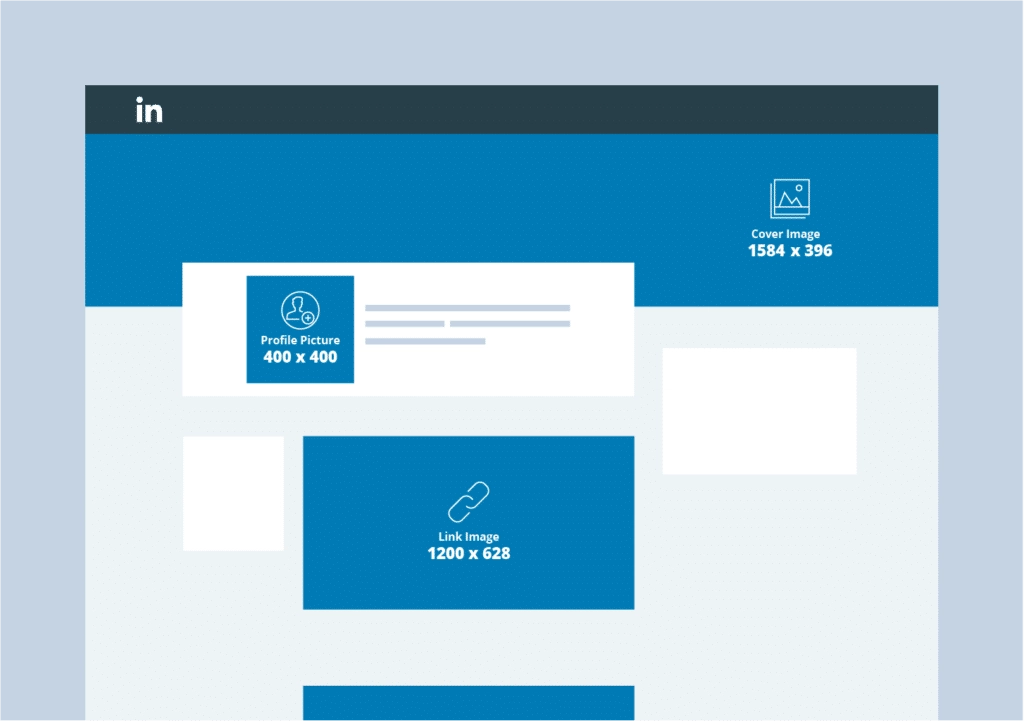
Choose a clear, friendly, and appropriately professional image. Follow the below tips to upload the profile picture.
For Profile Picture;
- Chose a photo that looks like you
- Face in the center of the frame
- Wear what you would wear to work
- Non-distracting background
For Background Photo/Image;
Choose a high-quality background picture that conveys something meaningful about you, too. The optimal size for your background image should be 1584 by 396 pixels.
- LinkedIn profile picture size: 400 x 400
- LinkedIn background photo size: 1584 x 396
- LinkedIn post image size: 1200 x 1200 (square) 1080 x 1350 (portrait)
- LinkedIn link post size: 1200 x 627
- LinkedIn video size: 256 x 144 (minimum) to 4096 x 2304 (maximum)
- Maximum LinkedIn video length: 10 minutes
Steps to follow
- Click on the existing photo to edit/change it or to add a new photo
- Use 400 x 400 pixels photo size for your LinkedIn Profile
- Add your stunning corporate-style photo.
- To change the background photo, click on the Edit (pencil symbol) on the right-hand side of your profile picture and add a background photo/change it with a new one.
Add all Your Contact Info
Add all your contact info, as this is the most crucial checklist; most recruiters or businesses always check for the contact details, so do not miss this for your Linkedin jobs search. Check to see that all fields contain your current information.
Pay close attention to spelling and number sequence to ensure inadvertent transposed numbers or misspellings don’t keep someone from getting in touch.
Follow all the guidelines on how to find jobs on LinkedIn.
You can add all the following details under the contact info on your LinkedIn profile page.
- Profile URL
- Add Website
- Phone (Mobile, Home, Work)
- Address (Home/Office)
- Email Address
- Instant Messenger (Skype, ICQ, Google Hangouts & Wechat)
- Birthday
Steps to follow
- Loin to your account
- Click on the “Contact info” as shown in the below picture.
- Add all the genuine and authentic contact info and save it.
Get a personalized LinkedIn URL.
LinkedIn automatically generates a profile URL for you during account creation, which looks like https://www.linkedin.com/in/yourname-1a123456/, which looks like a clunky combination of numbers.
You can change it at your will, and It’s much easier to publicize your profile with a customized URL (ideally linkedin.com/yourname) rather than that LinkedIn assigned to you.
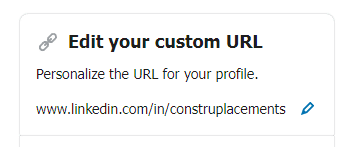
How to get one? Follow the below steps to get your custom URL.
Steps to Follow
- Login to your Linkedin account
- Click on your Name
- Click on “Edit public profile & URL” on the right side of your LinkedIn profile.
- In the new window on the “Public Profile settings” page, click on the “Edit your custom URL” at the upper right side of the page, click on the pencil symbol and edit it with your desired name, which will remove the number and create a new custom URL for you.
- You can also change/edit the profile visibility preferences from this screen.
A well-written Headline and Summary (About Page)
No headline is the same. Whether you’re calling out the opportunities you’re creating, unique talents, or company, a good headline helps candidates and clients understand your mission and impact.
A well-crafted headline implies that you’ve taken time to make the rest of your profile more enjoyable for your Linkedin jobs search.
Your headline doesn’t have to be your job title and company; especially if you’re looking for jobs, it shouldn’t be.
Instead, use that space to succinctly showcase your specialty, value proposition, or your “so what?” The more specific you can be about what sets you apart from the competition, the better you learn about finding jobs on LinkedIn.
In your headline, describe what you do in under 220 Characters.
Headline Examples:
Healthcare Consultant | Vice President Pharmacy | Vice President Healthcare | VP Pharmacy Sales Software Engineer | Technical Sales Account Executive | Technical Software Sales Civil Engineer | Fresher | Job Seeker | Ready To Work On Your Project Fresh Civil Engineer Looking for the Job
You can also check the Great LinkedIn Profiles You Should Look Up To.
About Page
Character limit: 2600
Be original and creative, yet also clear and informative. Include relevant industry keywords. That will make it easier to find when people search for professionals in your field.
The summary section allows you to add images, videos, documents, and links, so add relevant pieces that show off your finest work.
People are starting to focus on future goals and ambitions; consider offering an audacious glimpse of your plans, ideas, and objectives.
Highlight recent experience.
Your work experience speaks a lot about you. Many hiring managers and recruiters will also view a candidate’s LinkedIn profile in detail before inviting them in for an interview.
Many job seekers don’t polish their LinkedIn profile, affecting their application response rate.
It’s essential to spend some time polishing up your profile and highlighting your recent experience to make your journey more rewarding for how to find jobs on LinkedIn.
- Convert work experience listed on your resume for LinkedIn.
- Copy the work experience from your resume over to your LinkedIn profile.
- Select significant achievements (quantifiable if possible) and remove the rest of the content.
- You may need to rewrite some of it, but you should end up with a few sentences highlighting your significant achievements.
Treat Your Profile Like Your Resume
Your resume isn’t just a list of job duties. It’s a place to highlight your best accomplishments. The same goes for your LinkedIn profile: Make sure your experience section is fleshed out with bullet points that describe what you did, how well you did it, and who is impacted. Use all the features available for your Linkedin jobs search.
Add a Public profile badge on your blog, online resume, or website.
Promote your profile by adding a badge to your blog, online resume, or website.
If you are a freelancer and have your online property, like a blog or website, you can easily add a LinkedIn badge and attract the client. You can also add the LinkedIn badge on your online resume to get attracted by the recruiters.
You can add it from the “Public profile settings” page. You can find it on the right side of the page. The detailed instructions to add the LinkedIn badge to your profile are below.
- Login to your Linkedin account
- Click on your profile picture.
- Click on “Edit public profile & URL” on the right side of your LinkedIn profile.
- You can see a “Create a badge” button at the right bottom corner.
- Follow the instructions to correctly add the badge to your profile, blog, resume, and website on the new page.

Let recruiters know you’re available.
Your LinkedIn profile may not be getting the attention you seek from recruiters. So, what’s wrong with your profile? Are you using LinkedIn correctly?
You can let recruiters and your network on LinkedIn know you’re open to new job opportunities with the #OpenToWork feature. Watch this explainer video on how to Enable or Manage #OpenToWork in your LinkedIn profile.
Build your network to the 1st-degree connections.
Your connections can exponentially increase your exposure and access to other connections. LinkedIn makes it easy to connect with people you know by importing your contact lists from sites such as Gmail.
Research the companies you’re interested in and follow them.
LinkedIn makes it easy to find and follow companies. If you haven’t already done so, make a list of the companies you’d like to work for, follow them on LinkedIn, and learn the tips for finding jobs. This will help you know about company news and new positions as they become available.
Use the Advanced Search.
Use LinkedIn’s Advanced Search option and search for your favorite companies, people, job contacts, schools, and groups. You can filter your LinkedIn connections based on the connections type (1st, 2nd, or 3rd), locations, and the current companies they are working for.
Find out which of your connections is associated with your future employer or from your business domain. Depending on their connection with the company, you can reach out to these people. If they work there, you can ask questions about the company culture.
If they are a client or service provider, you can ask what it’s like to do business with them. Get creative and have fun doing your research to navigate how to best approach the company for a job when you’re ready.
Show Your Achievements
Recruiters spend countless hours scouring LinkedIn in search of high performers. And when they find them, they contact said high performers.
Knowing this, you’ll serve yourself well to market yourself as a high performer in your summary and experience section (think action words, accomplishments, talking about times you’ve been promoted or hand-picked for projects).
Get involved in LinkedIn Professional Groups.
Do an Advanced Search to identify professional groups in your area and get involved in your Linkedin jobs search.
This will help expand your network, show your expertise (when you engage in online conversations and answer questions), and possibly connect you to the future organizations you want to work for.
When researching groups, you want to participate in groups that have recent activities. Otherwise, you might be wasting your time if a group doesn’t have daily or regular interaction online.

As shown in the above figure, type the search term in the search box, search the groups relevant to your interests, and send a request to join the group.
Research your future boss and executive team.
Before going in for an interview, you can use LinkedIn to research hiring managers and interviewers to find their likes, interests, etc. You can leverage this information to create relatability and show that you’ve done your homework during your consultation.
Networking with the right people.
LinkedIn has 310 million active users per month, 40% of which visit it daily. 77% of recruiters are on LinkedIn. The average LinkedIn user spends 17 minutes on the site per month.
These figures indicate that you might get more interaction and exposure if you update your status, network, and connect with people and companies after business hours on LinkedIn. Test this out at different times of the day to see what works best in getting responses and other interactions.
Optimize your profile’s search visibility.
Like other social media platforms, LinkedIn has an algorithm. There’s no silver bullet to propel your profile to the top, but there’s plenty you can do to make yourself more visible, such as:
- Include relevant keywords in your headline
- Add your location to your profile
- Insert impressive work samples
- Complete your contact information
- Showcase volunteer or charitable interests
- Join industry-centric groups
Follow all the above-proven strategies to master the skills in how to find jobs on LinkedIn?
Searching for Jobs on LinkedIn
You can use LinkedIn to search and apply for job opportunities that companies and recruiters post based on keywords, titles, or locations. If you don’t want to apply for a job at the moment, you can save it by clicking Save above the job description.
You’ll be able to access your saved jobs at any time to begin the application process. Here’s how you can search for a job that suits your professional skills and specifications.
Job seeking preferences settings
Before applying or searching for jobs, you need to make necessary changes to your job-seeking preferences; LinkedIn has given us significant preferences to make our job searching experience hassle-free. Click on all the available fields and make the necessary changes.
To change your preferences, click here. You can also access this page from your home page in “Settings & Privacy” under the “Me” tab on the top bar.
How to search for jobs on LinkedIn
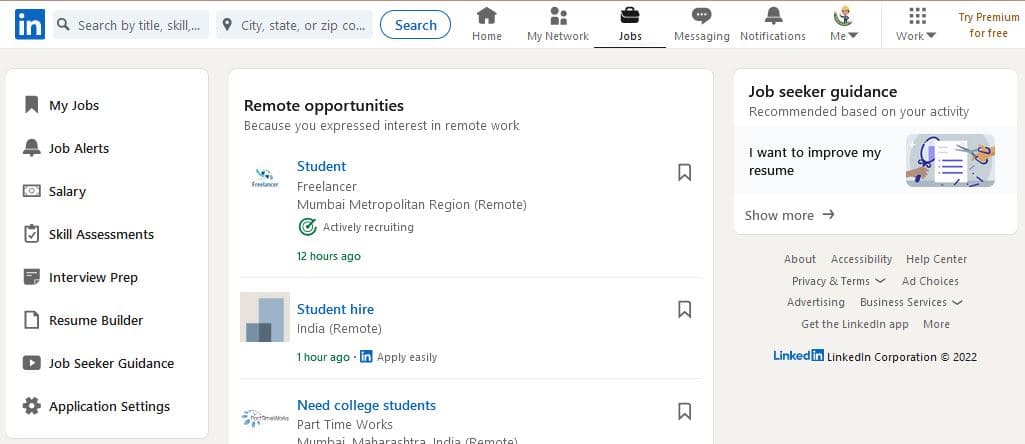
Steps to follow
1. Click the Jobs icon at the top of your LinkedIn homepage while login into your LinkedIn account. Direct link https://www.linkedin.com/jobs/
2. In the Search jobs field, type a job title, keyword, or company name. Keep in mind that you can use Boolean search modifiers to help refine your job search.
3. You can use the Search location field to type a city name, state/province/territory name, or country name. A drop-down list will appear where you can select your desired location. Your preferred location may be pre-filled for you, but it can be updated by typing a different one into the text box.
4. Click Search.
5. Use the filters at the top of the page to refine your search by Date Posted, LinkedIn Features(including In Your Network, Under 10 Applicants, and Easy Apply), Company, Experience Level, etc. Click All filters to view additional filter options to make it more perfect on how to find jobs on LinkedIn.
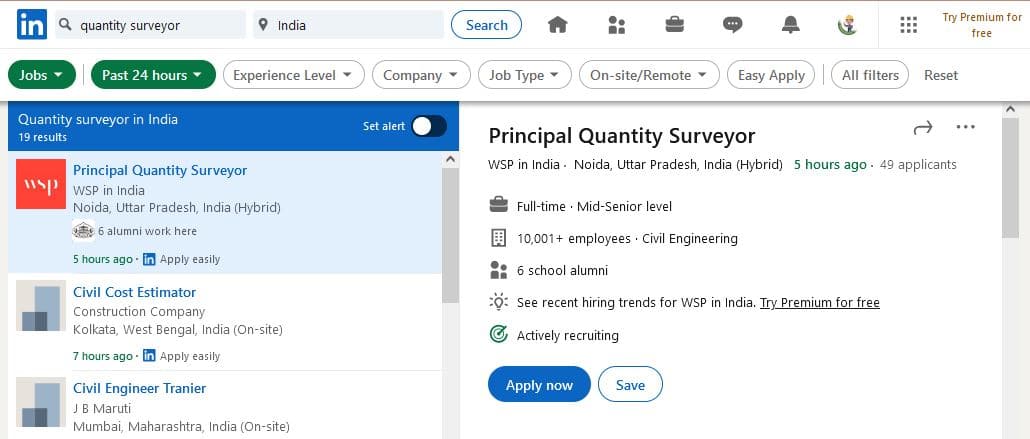
i. You can click the Sort by drop-down at the top of your search results to sort your search by date posted, Experience Level, Company, Job Type, On-site/Remote/Hybrid, Easy apply & All filters.
ii. The number of days the job has been posted is listed at the bottom of each job summary.
6. Click a job title to view the job details.
7. Click Easy Apply or Apply (options may vary). Learn more about applying for jobs on LinkedIn.
Search on LinkedIn
The search bar is at the top of any LinkedIn page you’re viewing, and it allows you to search for people, jobs, companies, posts, and more.
You can click any suggestions that appear in the dropdown list as you type or submit your search to see the full results.
User-generated content (Post) on LinkedIn
LinkedIn is the largest professional network, so that you will find all the stuff written by LinkedIn users. It can be used as a Linkedin jobs search tool. You can find the particular things by typing the keyword in the search box and type of content to find the content written on your specific topic or interests.
Many recruiters also post the jobs in posts and content, so you can follow the recruiters from your industry sector to get a regular feed of the jobs-related posts.

In the above picture, you can see that I have put “civil engineering hiring” as a search term; after clicking search on the top menu bar of LinkedIn, it shows results for the search term “civil engineering” plus “hiring” and also gave me some preferences to choose from, like Posts, Date Posted, Posted by, and Sort by. Other filter terms are also shown in the above image.
To make the above result more relevant, I have filtered out the search result for “Posts” and “Date Posted.”
Likewise, you can search for any search term and narrow it down by selecting your desired broad time.
To search a content (job), write a career in the search box, and click on the content. You will get a list of all the posts (jobs) posted by the recruiters and other LinkedIn users. As shown in the above picture, if you type “civil engineering hiring” and hit search, you will get a feed of civil engineer job content.
You can narrow down your search by using the filter option shown in the picture to perfect how to find jobs on LinkedIn.
Linkedin Advanced Search
You can run a Boolean search on LinkedIn by combining keywords with operators like AND, NOT, and OR during your search.
Here are some ways to use Boolean logic and construct your searches:
Quoted searches: For an exact phrase, enclose the phrase in quotation marks. For example, type “product manager”. You can also use quotation marks if you want to find someone with a multi-word title.
- LinkedIn search only supports standard, straight quotation marks (“). Other software or websites may use special symbols that our system does not recognize. Curly quotation marks (“), also known as smart quotes or typographer’s quotes, aren’t supported.
- In order to optimize overall site performance, stop words such as “by”, “in”, “with”, etc. aren’t used.
NOT searches: Type the word NOT (capital letters) immediately before a search term to exclude it from your search results. This typically limits your search results. For example, “programmer NOT manager”.
OR searches: Type the word OR (capital letters) to see results that include one or more items in a list. This typically broadens your search results. For example, “sales OR marketing OR advertising”.
AND searches: AND searches: Type the word AND (capital letters) to see results that include all items in a list. This typically limits your search results. For example, “accountant AND finance AND CPA”.
Parenthetical searches – To do a complex search, you can combine terms using parentheses. For example, to find people who have “VP” in their profiles, but exclude “assistant to VP” or SVPs, type VP NOT (assistant OR SVP).
Conclusion
LinkedIn is an excellent place to find career opportunities if used smartly. If you follow all the steps and tips mentioned in this article, you will surely succeed in your mission to find an excellent job.
Howtowrite.Customwritings.com will find many tips and guides for an impressive resume. But don`t forget, while applying for a job, you may still be required a traditional CV, cover letter, etc. Think of the LinkedIn jobs search as a more dynamic and visual version of your resume.
Happy Job Hunting!!!
Related Posts:
- How to Leverage LinkedIn for a Career in Construction
- 5 Effective Steps To Make A Better LinkedIn Profile
- How do you search for civil engineering jobs in Pune?
- 28 Most Common Construction Tools with Names and Pictures
- LinkedIn For Job Search: How to Find Jobs On LinkedIn
- The Ultimate Guide to LinkedIn Search: Tips, Tricks, and Advanced Techniques
- 5 Effective Steps To Make A Better LinkedIn Profile In 2025


